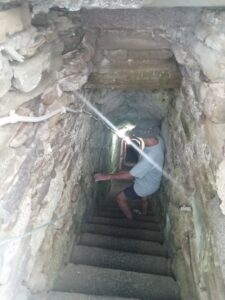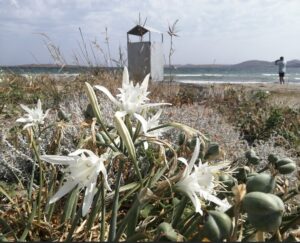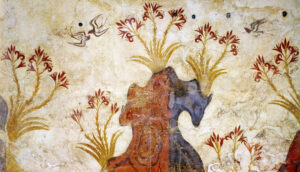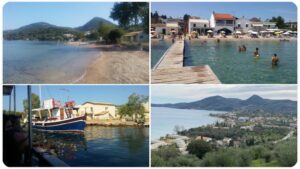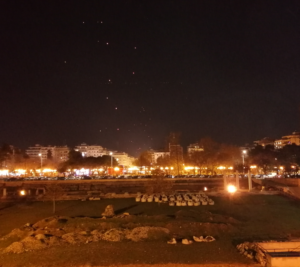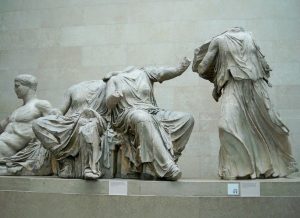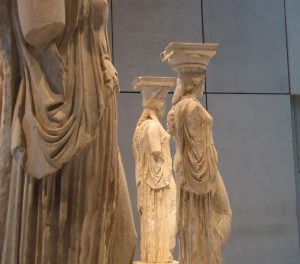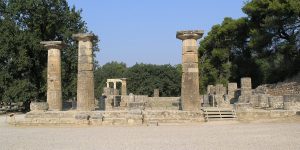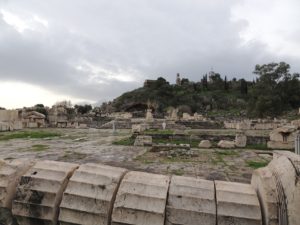Maroula, the heroine of Kotsinas
We visited Kotsinas on a windy morning last month, during our stay on the island of Limnos. As soon as we reached the top of the small artificial hill we felt as if we were suddenly on the sea and no longer on land, thanks to the beautiful decoration of the place and the vast sea stretching out before us.
The rounded fence at the far end made the place resemble the bow of a ship. We felt almost like we were sailing on the tumultous sea below. And, if that were indeed a ship, then, undoubtedly, its name would be ‘Maroula’, a name greatly revered in Kotsinas, and on the entire island, as a matter of fact.
Maroula was an eighteen-year-old girl back in 1478, when the fort of Kotsinas was beseiged by Suleiman Pasha. Her father was a soldier defending the fort. When the Turks murdered him before her very own eyes, Maroula felt enraged. She picked up her father’s sword swiftly and began to charge against the Turks.
The other villagers, inspired by her amazing act of bravery, despite her being just a girl and so young, followed suit and attacked the Turks with great force, causing them to flee. At the time, the fort was occupied by Venetian forces, who defended the fort that day together with the locals.
Some sources claim that perhaps Maroula was the daughter or the wife of the slain fighter Georgios Makris. In any case, the bravery of Maroula has been praised by Italian writers, such as Sabelico, Coelius, Calcagnini, Fulgosius, and Vianoli as well as by Greek writers Kostis Palamas, Aristomenis Provelengios, Maria Lampadaridou-Pothou, and Anthony Soupios.
Today, the bronze statue of Maroula stands where the fort once used to be. It reminds the visitor that acts of tremendous bravery that involve love for family and country can never fade in the course of time, but continue to inspire the next generations for centuries to come.
As you can see, a beautiful little church, ‘Zoodohos Pigi’, stands on the same hilltop. The name in Greek, ‘Life-giving Spring’ is a dead giveaway for what hides deep underneath it…
 Under the church begins a descent in search of holy water…
Under the church begins a descent in search of holy water…
Before visiting Kotsinas, I had viewed travel videos from the place and I knew about the descent of about 60 steps that reaches deep down under the church, where the bowels of the fort once used to be.
The thought of experiencing this descent enthralled me. Sure, it also elicited an eerie feeling in me, but I was determined to suppress it and to actually do this!
Well, it was easier than I thought. The kindly lady I asked for directions at the church showed us the stairs and swiftly turned on the lights for us. It was an instant improvement of the view haha.
There was a rope to hold on to as the stone steps could prove slippery, or so we were told. But we had no such issues. From the top looking down, the passage seemed daunting and long, but our apprehension soon evaporated. It took way shorter a time than we’d thought to get to the tiny cavernous space at the bottom.
There is a small bucket you can use down there to get water from the well. People have left icons down there and they inspire the visitor towards prayer and concentrated thought.
I confess, I didn’t drink from the well, but I took some of the water in my hand to sprinkle on all the achy and ailing bits on my person that seem to get more and more in number as I age, LOL. So, after a short prayer to the Virgin Mary we took the steps back up to the top. The ascent was equally quick and didn’t require any great effort.
All in all, this was a wonderful experience in an unusual place that will stay with me forever. I highly recommend it!
GO HERE to see the photographs from our visit to Kotsinas.
For a video of the hilltop, go here
For a video of the well underground, go here
The famous ‘Lily of the Virgin Mary’ is strewn all over Kotsinas Beach
This beautiful lily can be found on the beaches in many parts of Greece, especially the southern coast of Crete. Personally, I have only ever seen it on the beach in Kotsinas, on Limnos island. When I visited it again this summer, it was mid August. The plants were in full bloom, making the beach scenery stunning against the backdrop of the foaming sea on that refreshing, windy day.
The Greeks often call this lily, ‘To krinaki tis Panagias’ (Lily of the Virgin Mary). The odd name is owed to the fact that this plant only blooms in the summer, including August, when The Virgin Mary is annually celebrated in Greece (on the 15th) .
The plant is a member of the Amaryllidaceae family and is a perennial bulbous plant. The Latin name is Pancratium maritimum, and it is known out of Greece with various names such as the sea daffodil, the sand lily or the lys de mer.
Its scent is heady and exotic, reaching the peak of its strength at the end of August. The fruit look like small pieces of charcoal that are so light they are taken by the wind and often seen floating on the seawater.
This lily is depicted on the ancient murals of the Palace of Knossos in Crete and also illustrated on the frescos and pottery of ancient Thira (Santorini). The Minoans in Crete regarded it as holy.
It isn’t just aesthetically pleasing, though. It also benefits the environment where it grows, helping to stabilize sand dunes, preventing erosion, and supporting the often fragile ecosystems where it blooms.
This precious flower has become quite rare these days because of increased tourism. The Council of Europe has declared it a rare and endangered species.
Please be cautious when walking on sand dunes to avoid stepping on them. Kindly think twice before picking them, and rather consider immortalising them in a photograph or two instead, just like I did, to remember them by!
OOPPAAA! SIGN UP TO MY BIMONTHLY NEWSLETTER AND GET 3 BOOKS FROM ME AS A WELCOME GIFT! SEE BELOW FOR THIS OFFER!
YOU KNOW WHAT THEY SAY… SHARING IS CARING! Tweet this to spread some love:
Interested in travel, food and books from Greece? Here's a blog you will love! #Greek #blogger #writer Share on X
Check out more of my travel posts here: https://effrosyniwrites.com/category/travels-and-weekend-breaks/
Special offer! Sign up below and get these books for FREE!
Planning to visit Greece? Check out my FREE guide to south Corfu!





